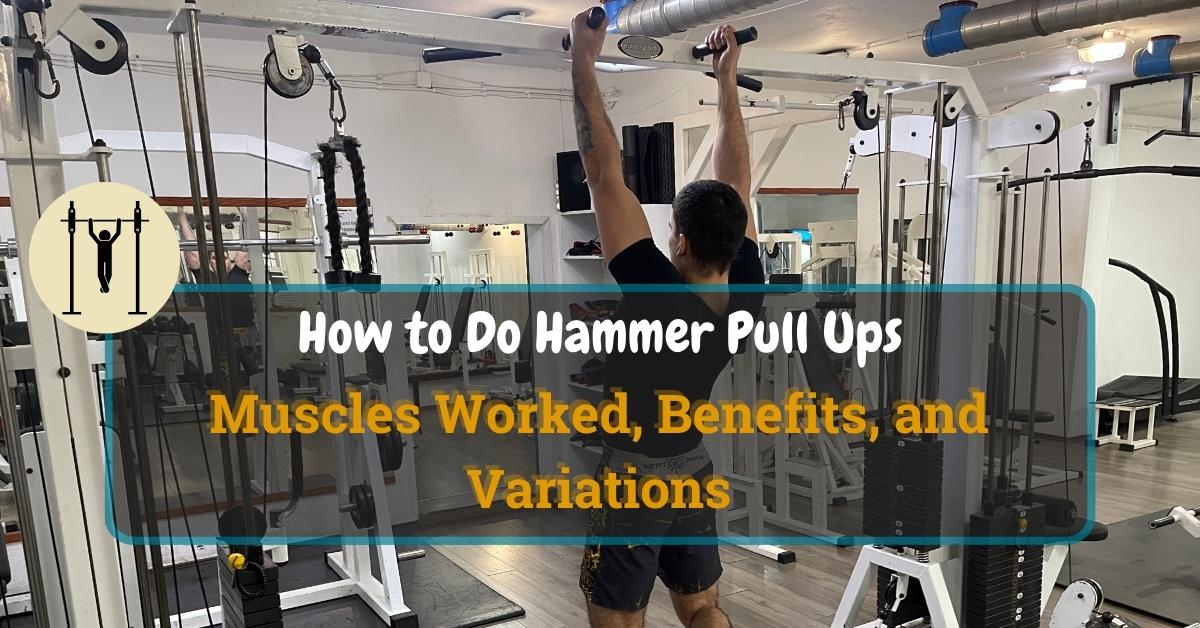Hammer pull ups are one of the best vertical pull exercises for developing strong back and bicep muscles. I often use hammer grip pull-ups during my pulling workouts or with my clients because they reduce the stress on your shoulders and rotator cuff.
Table of Contents
ToggleA study from the PubMed website suggests that muscle activation patterns remain more or less the same across different pull-up variations [1]. However, one thing that separates neutral grip pull-ups from supinated and pronated variations is how shoulder-friendly they are.
Also, when you are pulling your chin above the handles, you are basically performing pure vertical pull movement. On the contrary, if you lack lower trapezius strength during pronated and supinated variations, you are more likely to perform diagonal pulls or something closer to rows in some cases.
The guide below will cover the proper form of hammer grip pull-ups, muscles worked, benefits, tips, mistakes, variations, and alternatives.
Start Building Your Dream Body Today
Ready to elevate your fitness game without falling into the trap of dull, repetitive routines that just don’t deliver? Imagine sculpting your ideal physique and boosting your health, all while still enjoying life’s pleasures, like those irresistible weekend getaways and your aunt’s legendary cheesecake. With our online fitness and nutrition coaching service, you don’t have to compromise. Dive into a personalized fitness journey that blends perfectly with your lifestyle, not against it. Book your completely free discovery consultation today, and take the first step towards a transformation that doesn’t require giving up the joys of life.

“I was skeptical about online fitness coaching, but Functional Body Savage completely changed my perspective. Vanja and Radomir’s personalized approach and attention to detail have helped me achieve goals I never thought possible. I’m stronger, more confident, and grateful for their guidance.”
Emily Thompson, San Francisco, CA
Learn More About Our Online Coaching ServiceHow to Do Hammer Pull Ups – Step-By-Step Guide
Here is how to perform hammer pull-ups without risking the chance of injury and to maximize your pulling performance.
Step One — Assume the Starting Position
First, locate the hammer pull-up bar in your gym. Stand below it and grab parallel handles with both of your hands. Your thumbs should “point” behind you. Hang from the bar without your feet touching the floor.
If you are taller than usual and you can’t hang from the bar without touching the floor, feel free to bend them or cross them. Now, the next part is crucial. Retract and depress your shoulder blades to enter the so-called active hang position. Keep your back straight and your eyes looking towards the handles.
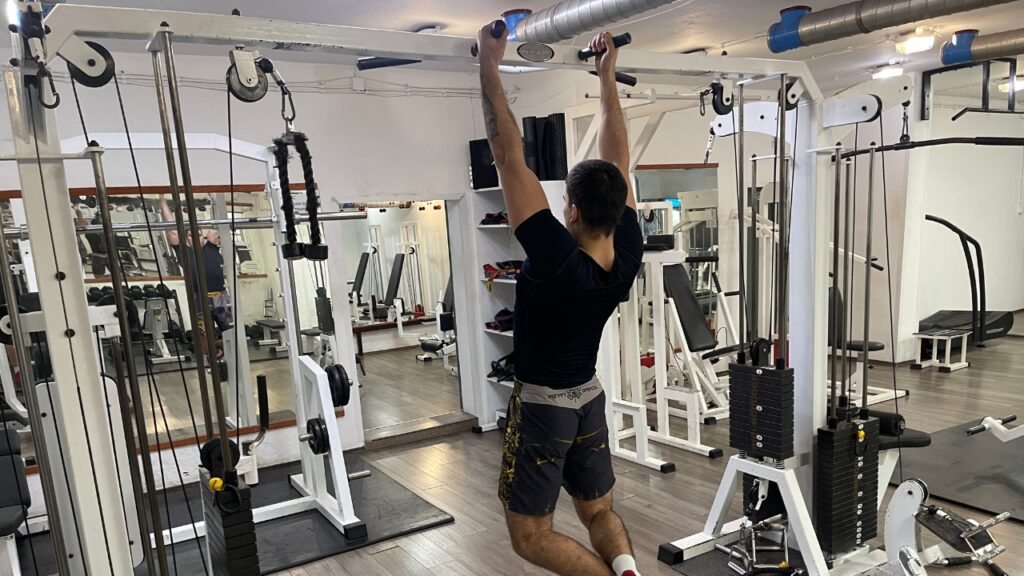
Pro Tip: Grip the handles strongly with all your fingers, especially your pinky finger. I say this because most individuals grip the bar strongly only with their 3 or 4 fingers, leaving some untapped potential for better grip strength.
Step Two — Pull Your Chin Above the Level of the Handles
Quickly pull your chin above the level of the handles by extending your shoulders and bending your elbows. Keep your eyes focused on the handles or just in front of you, depending on your preference. Once your chin is above the level of the handles, hold that position for one second.
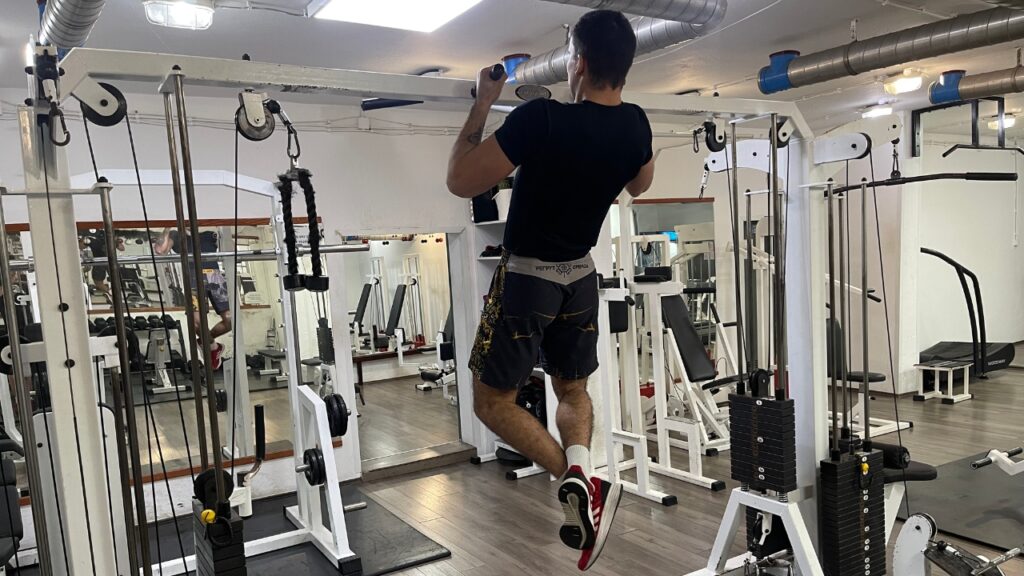
Pro Tip: If you can’t perform a proper neutral pull-up technique because you move away from the bar during the pull-up motion, that means you have weak lower traps. To fix this, perform chest-supported Y raises at least once or twice weekly. This will strengthen your lower traps and allow you to enter a proper neutral pull-up position from the beginning.
Step Three — Lower Your Body to the Starting Position
Slowly lower your body to the starting hanging position by bending your shoulders and extending your elbows. Make sure you maintain proper form throughout the entire movement without lateral movement or going away from the handles.
When your elbows are fully extended, slowly protract and elevate your shoulder blades. To proceed to the next rep, retract and depress your shoulder blades and repeat the entire process again.
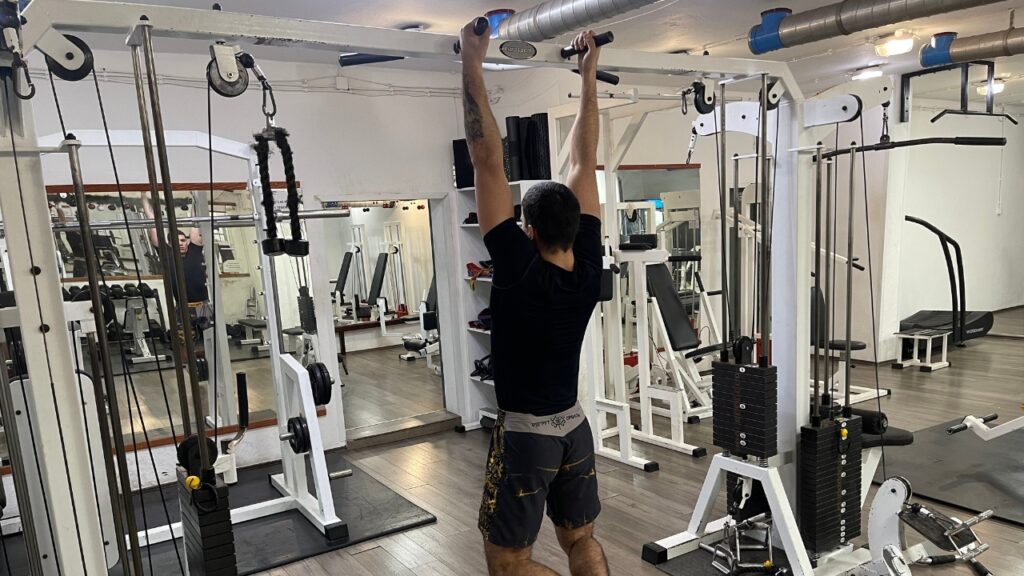
Pro Tip: Slowly lower to the starting position to increase the time under tension (TUT). This will allow you to improve your mind-muscle connection while also helping with muscle hypertrophy since the intensity will be greater.
Hammer Pull-Ups vs Pull-Ups
While both hammer pull-ups and regular pronated and supinated pull-ups are more or less the same, there are some differences worth noting. First, neutral grip pull-ups are much better for your shoulders since they immediately place them in the neutral position at the beginning of the exercise.
What this does is place less stress on your shoulder joint and rotator cuff, which is excellent for beginners with insufficient levels of strength and people experiencing rotator cuff and shoulder injuries.
Also, hammer pull-ups are right in between pronated and supinated pull-ups in terms of bicep activation. Hammer pull-ups, due to the neutral grip position, will target your brachialis and brachioradialis muscles more. The supinated grip will use the strength and power of your bicep brachii the most out of all three variations.
Hammer Pull Ups Muscles Worked
The primary muscles working during hammer pull ups include:
- Latissimus dorsi
- Bicep brachii
- Brachialis
Also, the secondary muscles working include:
- Brachioradialis
- Trapezius
- Rhomboids
- Forearm muscles
- Posterior deltoids
Hammer Pull Ups Benefits
Here are the most important hammer pull-up benefits you can expect if you decide to implement this exercise into your workout routine.
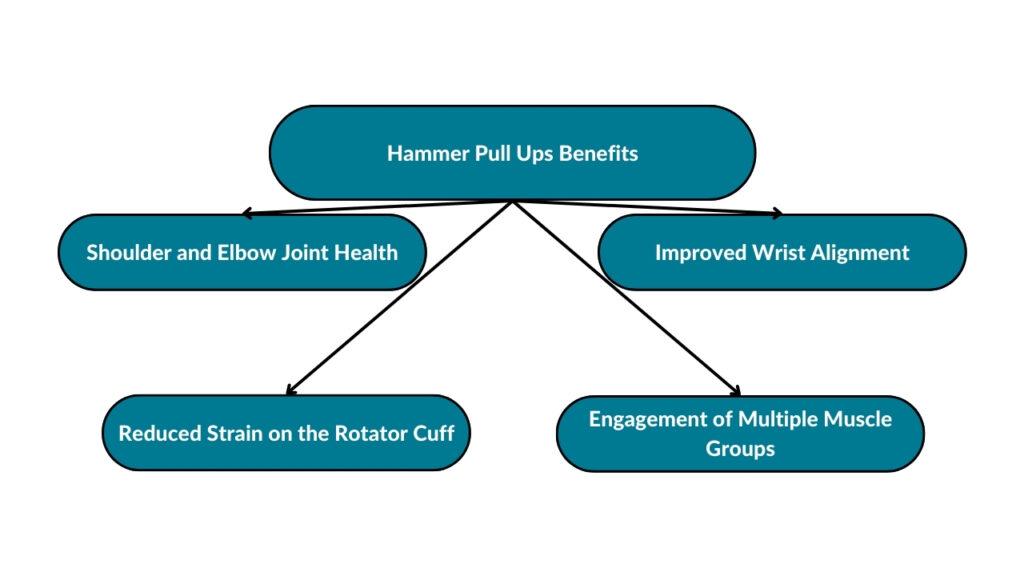
Shoulder and Elbow Joint Health
Hammer pull ups will dramatically improve your shoulder and elbow health. What helps here is the starting position during hammer grip pull-ups, which is neutral. A neutral shoulder starting position is excellent for beginners and people experiencing rotator cuff and similar injuries.
Overall, if you are experiencing difficulties and limited range of motion regarding your internal and external shoulder rotation, try implementing neutral grip pull-ups in your workouts.
Reduced Strain on the Rotator Cuff
Reduced strain on your rotator cuff is another benefit that will enable you to perform more pull-ups with proper form. Nowadays, many people experience problems with their rotator cuff, thus making exercise selection crucial during their workouts. The only better pull-up variation in terms of rotator cuff and shoulder health is ring pull-ups.
Gymnastic rings are one of the best pieces of equipment that will allow your shoulders to achieve a natural range of motion and place the least amount of stress on your shoulders. However, stabilization is crucial here as well, making gymnastic ring pull-ups that much harder, looking from a stability perspective.
Engagement of Multiple Muscle Groups
Neutral grip pull-ups will effectively engage multiple muscle groups, such as your lats, rhomboids, and biceps brachii. Neutral pull-ups are one of the most efficient pulling exercises I regularly implement in my workouts. It’s crucial to always change the pull-up variations you perform during your pull workouts so you avoid plateaus.
Improved Wrist Alignment
There isn’t any radial movement and rotation during hammer grip pull-ups, making this exercise perfect if you want to keep your wrists aligned and parallel to each other. Wrist pronation and supination are useful during other pull-up variations.
Still, we mustn’t forget to include a neutral grip as well, just to add that bit of versatility and additional muscle activation during our workouts.
What Are the Best Tips for Performing Neutral Grip Pull-Ups?
The best tips for performing neutral grip pull-ups include utilizing controlled eccentric movements, incorporating isometric holds, experimenting with your grip width, focusing on scapular retraction, and gradually progressing with resistance bands in case you lack base levels of pulling strength.
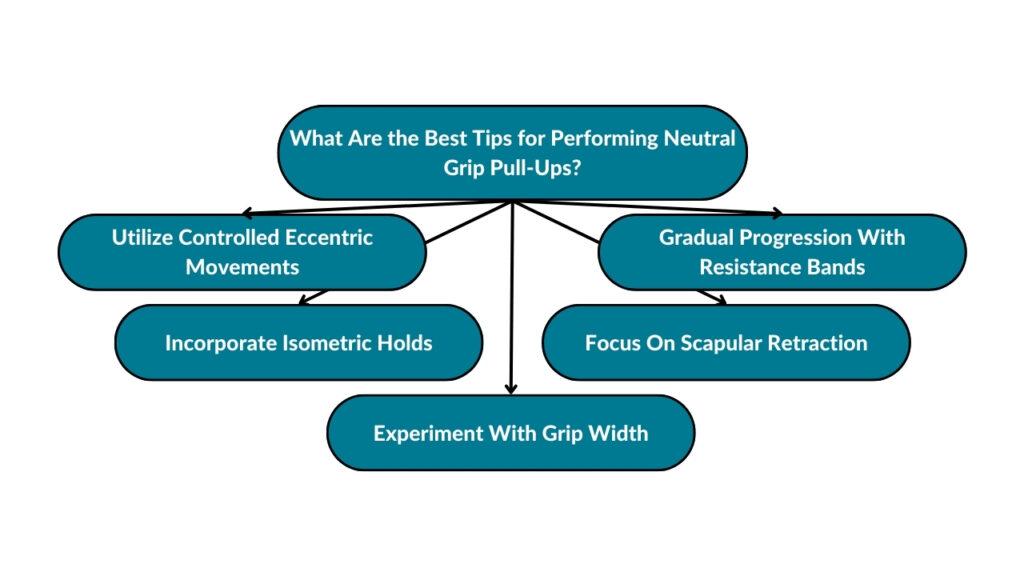
Let’s tackle each of these separately.
Utilize Controlled Eccentric Movements
Controlled eccentrics or the lowering portion of the lift is crucial if you want to maximize your mind-muscle connection and help build proper movement stereotypes. Also, there is some evidence to suggest that controlled eccentric movements are good for lowering the chance of injuries.
A study from PubMed Central found that eccentric exercise is being increasingly used within exercise protocols, especially for injury rehabilitation and prevention, as well as for improvement of athletic performance [2].
Injury reduction and prevention are crucial in today’s professional sports since they prolong the professional careers of athletes, thus giving them a better chance of achieving higher goals and better performance and results in their lifetime.
Incorporate Isometric Holds
Isometric holds are one of the best ways to increase your base levels of strength quickly. I remember reading a book from my professor in college about different ways of improving your strength levels. Isometrics was definitely one of them, even though the plateau of strength was noticed only after 6 weeks of intensive isometric workouts.
This means you can effectively implement isometric exercise for up to 6 weeks to increase your base levels of strength. This is crucial for beginners as isometric exercises are much safer and easier to perform in terms of proper technique and form.
Experiment With Grip Width
You can try different neutral grip widths to change muscle activation patterns. This will also change the amount of activation across primary and secondary muscle groups during hammer pull-ups.
I generally recommend starting with a shoulder-width grip if the equipment allows you to do so. From then, change to narrow and wider grips every other workout to avoid fixed muscle adaptations and not progressing further.
Focus On Scapular Retraction
It is crucial you retract and depress the scapula or your shoulder blades at the beginning of each subsequent neutral pull-up. What scapular retraction does is it places you in the correct starting position where the trajectory of your lifting motion becomes linear and in line with the handles.
Otherwise, if you fail to retract and activate your lower traps, you will likely move away from the bar and internally rotate your shoulders and round your thoracic spine during the pull-up motion.
Gradual Progression With Resistance Bands
If you can’t perform a bodyweight neutral grip pull-up, you may use the help of resistance bands to make the exercise that much easier. Start with harder pull-up resistance bands and progress with weaker ones so you one day transition to a regular bodyweight exercise.
What Are the Most Common Mistakes During Neutral Pull-Ups?
Incomplete range of motion, using excessive momentum, neglecting scapular retraction, overlooking core engagement, and ignoring breathing techniques are the most common mistakes during neutral grip pull-ups.

Let’s cover each of these common mistakes briefly.
Incomplete Range of Motion
When doing neutral grip pull-ups, you should perform them through the full range of motion. If you only do a partial range of motion, you risk forming muscle imbalances. Fully lock out your elbow in the bottom position, and make sure your chin is above the level of the handles in the top position.
Using Excessive Momentum
Most of my clients and individuals in the gym I see who lack strength want to compensate by doing hammer pull-ups with the swinging or using the momentum created in the bottom portion of the lift.
Avoid this at all costs, as you are likely going to break your technique and not target your muscles efficiently.
Neglecting Scapular Retraction
Neglecting scapular retraction at the start of the exercise will cause your form to break and move you away from the bar. That’s why I offered a guide in the sections above from incline Y raises so you can develop lower trap muscles and ensure proper form and technique from the start.
In case you simply aren’t aware of this little step before neutral pull-ups, all you need to do is retract and depress your scapula, which will cause you to enter the so-called active hang position.
Overlooking Core Engagement
Not engaging your core will cause instability during the pull-up movement. You must activate your abs and glutes to make sure your torso is fixed in the sagittal plane of motion. This will enable you to perform the exercise efficiently and with proper form, resulting in a lower chance of injury and improved exercise performance. Regularly doing functional core exercises can drastically help with your hammer pull-up technique.
Ignoring Breathing Technique
Poor breathing technique will come at the cost of your exercise performance and energy production. First, never forget to breathe during the reps. What I mean is inhaling after a few reps because your breathing reflex forced you to. Second, inhale during the lowering phase of the lift and exhale during the ascending phase of the lift.
Hammer Pull Ups Variations
Here are the best hammer pull-up variations you should consider adding to your pulling workout routine.
Weighted Hammer Pull-Ups
Weighted hammer pull-ups are an advanced variation of the bodyweight neutral grip pull-up, incorporating additional resistance to enhance upper body strength and muscle development. This exercise targets the lats, biceps, and forearms, contributing to a well-rounded upper-body workout.

Coaching cues:
- Attach a weight plate or use a weighted vest to add resistance. Choose a sturdy pull-up bar with enough clearance.
- Grab the bar with a neutral or hammer grip (palms facing each other). Ensure a grip width that is comfortable for your shoulders.
- Assume a hanging position from the bar with arms fully extended. Engage your core musculature and maintain a straight body position.
- Initiate the pull by squeezing your scapula together.
- Pull your chest area towards the bar in a controlled manner.
- Bring your chest to the bar, elbows close to your sides.
- Pause at the top to maximize muscle engagement.
- Lower yourself with control, fully extending your arms. Avoid excessive swinging or kipping movements.
- Inhale during the descent phase.
- Exhale as you exert force to pull yourself up.
Pro Tip: To optimize your performance in weighted hammer pull-ups, gradually increase the resistance to challenge your strength. Focus on controlled movements throughout the entire range of motion, emphasizing the engagement of your lats and biceps for maximum benefit.
L-Sit Hammer Pull-Ups
L-sit hammer pull-ups combine the challenges of both an L-sit hold and a pull-up, targeting the core, lats, and biceps for a comprehensive upper body and abdominal workout.

Coaching cues:
- Hang from the bar with a hammer grip. Engage the core and lift your legs into an L-sit position.
- Maintain a neutral grip. Keep legs straight, forming an L-shape.
- Squeeze shoulder blades together. Pull your chest towards the bar.
- Simultaneously, lift your legs higher in the L-sit. Aim for a seamless integration of pull and leg lift.
- Bring your chest close to the bar. Maintain the L-sit throughout.
- Lower with control, extending arms fully. Gradually lower legs back down.
- Inhale during the descent. Exhale while pulling up.
- Perform desired reps with proper form. Include in advanced upper body routines.
Pro Tip: Focus on maintaining the L-sit position throughout the pull-up for enhanced core engagement. Gradually increase the difficulty by extending the duration of the L-sit hold between repetitions.
Towel Hammer Pull-Ups
Elevate your upper body workout with towel hammer pull-ups, intensifying grip strength, targeting forearms, and engaging key upper body muscles.
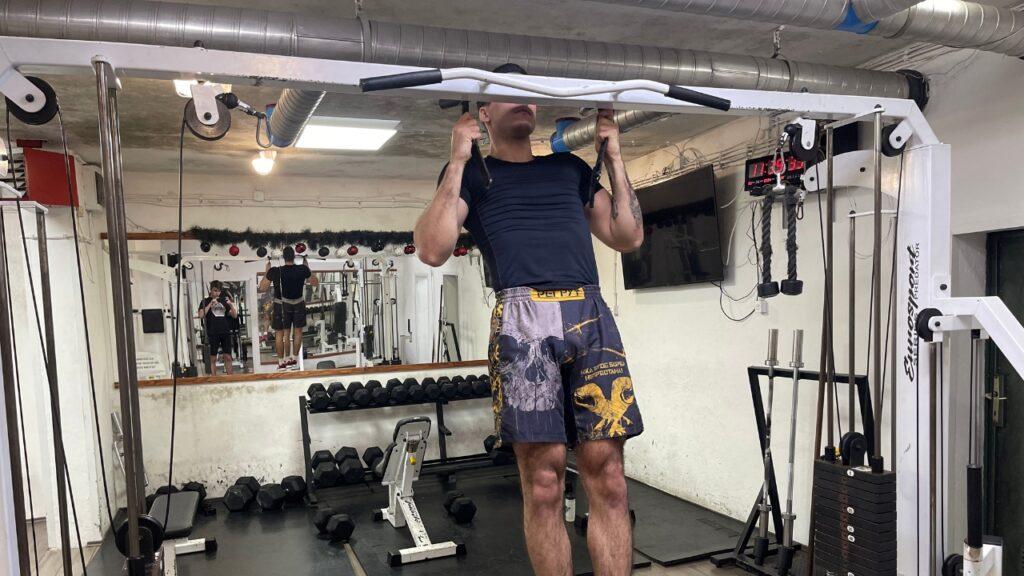
Coaching cues:
- Hang a thick, sturdy towel on the bar for durability.
- Grab each end with a neutral grip to activate diverse muscle groups.
- Prioritize core engagement and maintain full arm extension for optimal form.
- Focus on squeezing your shoulder blades together to activate the back muscles effectively.
- Pull your chest towards the towel, emphasizing the contraction at the top of the movement.
- Keep your body straight throughout, avoiding excessive swinging.
- Aim for a complete range of motion, lowering yourself with controlled precision.
- Ensure a tight grip on the towel throughout the exercise to challenge forearm strength.
- Inhale during the descent, exhale forcefully as you pull yourself up.
Pro Tip: Experiment with different towel thicknesses or progress to a single-arm grip to continually challenge and enhance your grip strength and overall muscle engagement.
Hammer Grip Pull Ups Alternatives
Here are the best hammer grip pull-up alternatives to consider.
Pronated Pull-Ups
Enhance your upper body strength with pronated pull-ups, targeting the back, biceps, and shoulders.
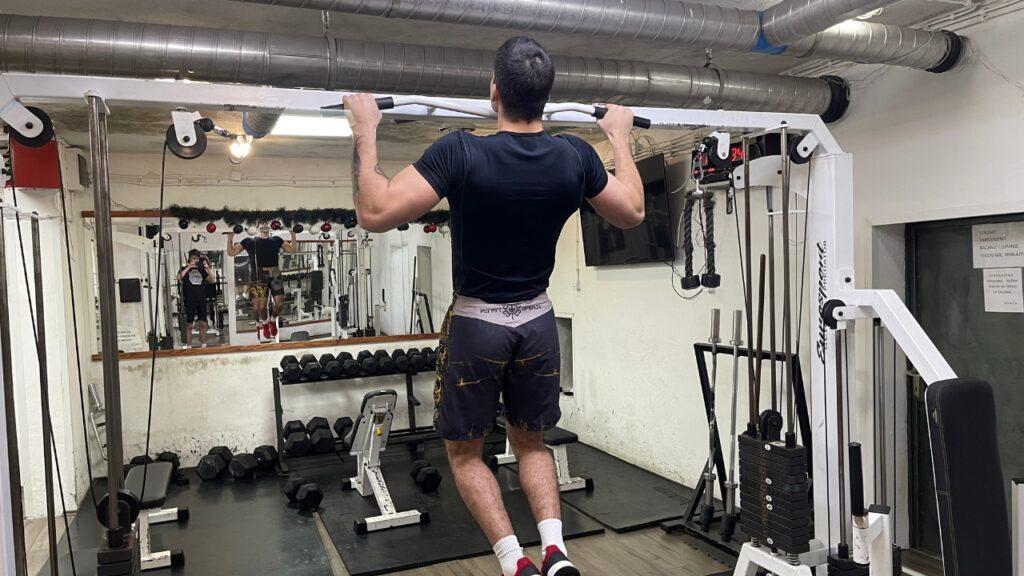
Coaching cues:
- Grab the bar with an overhand grip, hands slightly wider than shoulder-width apart.
- Hang with arms fully extended, engage your core, and retract your shoulder blades.
- Pull yourself up, leading with your chest, until the chin clears the bar.
- Lower down with control, fully extending your arms.
- Perform the desired reps for a complete upper-body workout.
Pro Tip: Focus on the controlled descent, emphasizing the negative portion of the movement, to maximize muscle engagement and strength gains.
Supinated Pull-Ups
Strengthen your biceps and target the upper back with supinated pull-ups.

Coaching cues:
- Use an underhand grip on the bar, hands closer than shoulder-width apart.
- Hang with arms fully extended, engage your core, and retract your shoulder blades.
- Pull yourself up, leading with your chest, until your chin clears the bar.
- Lower down with control, fully extending your arms.
Pro Tip: Ensure a full range of motion by lowering yourself completely, engaging both biceps and back muscles for balanced development.
Close Grip Pull-Ups
Focus on your inner back and arms with close-grip pull-ups, a variation targeting different muscle groups.
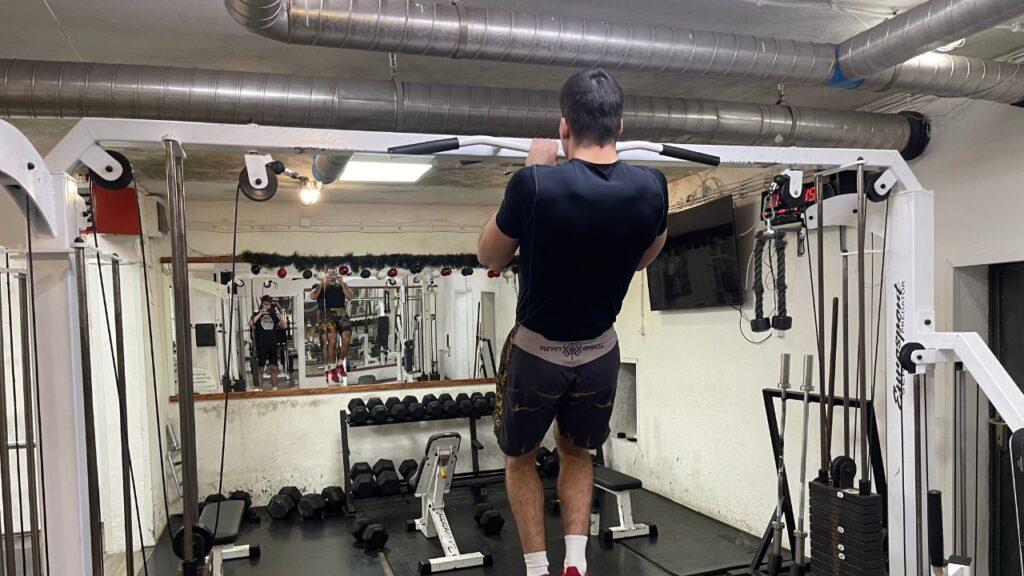
Coaching cues:
- Use a narrow grip on the bar, hands positioned close together.
- Hang with arms fully extended, engage your core, and retract your shoulder blades.
- Pull yourself up, leading with your chest, until the chin clears the bar.
- Lower down with control, fully extending your arms.
- Perform the desired reps for a specialized upper body workout.
Pro Tip: To intensify the exercise, consider adding weight gradually or incorporating pauses at the top and bottom of the movement.
Inverted Rows
Build a strong back and improve posture with inverted rows, a bodyweight exercise suitable for various fitness levels.
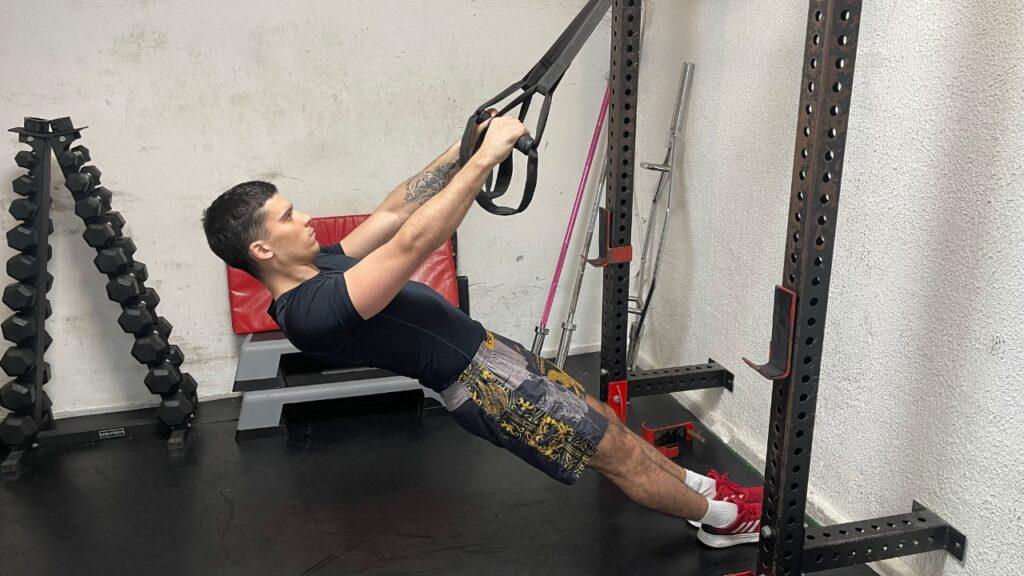
Coaching cues:
- Set up a suspension trainer or a bar at waist height, lie beneath it, and grasp the bar with an overhand grip.
- Keep your body straight and engage your core musculature.
- Pull your chest towards the bar, squeezing your shoulder blades together.
- Lower your body with control, maintaining a straight line.
Pro Tip: Experiment with different grip widths and hand positions to emphasize different parts of the back and arms.
Lat Pulldowns
Isolate your lat muscles and enhance overall upper body strength with lat pulldowns.

Coaching cues:
- Sit at a lat pulldown machine and grip the bar with hands wider than shoulder-width.
- Keep your back straight, engage your core, and pull the bar down towards your chest.
- Control the bar as you raise it back up, fully extending your arms.
- Perform the desired reps to target your lat muscles effectively.
Pro Tip: Focus on a full range of motion, allowing the lat muscles to stretch and contract for optimal development. Also, experiment with unilateral lat pulldown variation for correcting muscle imbalances.
FAQs
What Is a Hammer Pull-up Bar?
The hammer pull-up bar is a piece of fitness equipment designed for performing neutral grip pull-ups. It has two parallel handles, allowing you to assume the starting neutral grip position during your workouts.
Are Hammer Pullups Good?
Yes, hammer pull-ups are good. Hammer grip pull-ups are good for developing your lats, bicep, and posterior deltoids and will reduce the stress on your shoulders and rotator cuff muscles during the pull-up motion.
Are Hammer Pull Ups Good for Beginners?
Yes, hammer pull-ups are good for beginners. Hammer pull-ups are good for beginners because the neutral grip is shoulder-friendly and will allow more help from upper arm and forearm muscles compared to the pronated (overhand) pull-up grip.
Why Are Hammer Grip Pull-Ups Easier?
Hammer grip pull-ups are easier than regular pronated pull-ups because they utilize your bicep and brachioradialis muscles more to complete the pull-up movement. However, this is why supinated grip pull-ups are even easier than hammer pull-up variation, assuming you don’t have any external shoulder rotation issues and rotator cuff muscle weaknesses.
What Is a Hammer Pull?
A hammer pull-up, also known as hammer grip pull-up, neutral pull-up, and neutral grip pull-up, is a pull-up variation with your palms facing each other and wrists in the neutral position without any pronation or supination.
Do Hammer Pull-Ups Work Biceps?
Yes, hammer pull-ups work biceps. Hammer pull-ups will also target your brachialis and brachioradialis muscles during the pull-up movement.
What Is the Healthiest Pull-up Grip?
A neutral grip is the healthiest pull-up grip because it reduces the stress on your shoulders and rotator cuff muscles.
How Far Apart Are Neutral Grip Pull-Ups?
Around your shoulder width is the proper width and how far apart your neutral grip pull-ups should be. However, you can experiment with the neutral pull-up grip with wider and narrower grips for increased exercise versatility and to trigger different muscle pattern activation.
How Many Neutral Grip Pull-Ups Is Good?
Anywhere from 6 to 12 neutral grip pull-ups is good. However, depending on your goals, the number of neutral grip pull-ups may increase or decrease, making this number highly subjective and goal-specific.
Are Neutral Grip Pull-Ups Better?
Neutral grip pull-ups are better than pronated and supinated grip pull-ups in terms of reduced stress on your shoulders and rotator cuff muscles.
Wrapping Up
Integrating hammer pull-ups into your workout routine offers a multitude of benefits, from strengthening your back and biceps to promoting shoulder and elbow joint health. The neutral grip position not only minimizes strain on the rotator cuff but also engages various muscle groups effectively.
By understanding proper form, avoiding common mistakes, and exploring variations like weighted and L-sit hammer pull-ups, you can optimize your upper body workout. Embrace the versatility and advantages of hammer pull-ups, fostering both muscle growth and joint health.
Start Building Your Dream Body Today
Ready to elevate your fitness game without falling into the trap of dull, repetitive routines that just don’t deliver? Imagine sculpting your ideal physique and boosting your health, all while still enjoying life’s pleasures, like those irresistible weekend getaways and your aunt’s legendary cheesecake. With our online fitness and nutrition coaching service, you don’t have to compromise. Dive into a personalized fitness journey that blends perfectly with your lifestyle, not against it. Book your completely free discovery consultation today, and take the first step towards a transformation that doesn’t require giving up the joys of life.

“I was skeptical about online fitness coaching, but Functional Body Savage completely changed my perspective. Vanja and Radomir’s personalized approach and attention to detail have helped me achieve goals I never thought possible. I’m stronger, more confident, and grateful for their guidance.”
Emily Thompson, San Francisco, CA
Learn More About Our Online Coaching ServiceReferences:
- Dickie JA, Faulkner JA, Barnes MJ, Lark SD. Electromyographic analysis of muscle activation during pull-up variations. J Electromyogr Kinesiol. 2017;32:30-36. doi:10.1016/j.jelekin.2016.11.004
- Križaj L, Kozinc Ž, Löfler S, Šarabon N. The chronic effects of eccentric exercise interventions in different populations: an umbrella review. Eur J Transl Myol. 2022;32(4):10876. Published 2022 Oct 21. doi:10.4081/ejtm.2022.10876

